Blooper 1: Home Page Identity Crisis
| < Day Day Up > |
Blooper 1: Home Page Identity Crisis
Home pages should allow website visitors to determine the site's purpose in a quick scan of the page. People want to quickly determine whether the site has something of interest to them. Home pages that don't let users easily do this commit not only a content blooper, but also a navigation blooper.
Look at the home page of PriceWaterhouseCoopers' web-site (Figure 1.1) and try to figure out what the company does. The home page offers few clues, so if you don't already know, looking at the home page probably won't help.
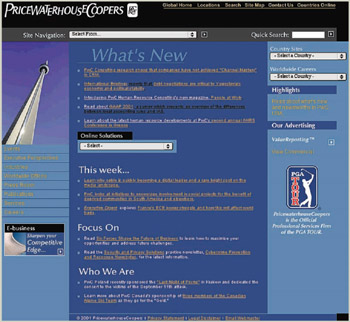
Figure 1.1: www.PWCGlobal.com (Jan. 2002)-Home page is vague about what this company does.
The navigation links and menus around the margins of the page could be for any business. The list of headlines in the middle suggests that it might be a business news service. The main thing suggesting the company's identity is the Who We Are section at the bottom middle of the page. What it suggests is that PriceWaterhouseCoopers is a foundation sponsoring international events.
In fact, PriceWaterhouseCoopers is a large accounting, auditing, and management consulting company. Where does it say that on its home page? On the bottom right, buried under a golf logo in hard-to-read white text, are the words ... Official Professional Services Firm of the PGA Tour. Not very helpful. First, professional services is an insider industry term that to outsiders means anything from lawyers to prostitutes. Second, even if you know what professional services means in this context, this tiny clue on the home page gives you no reason to believe that PriceWaterhouseCoopers provides services for anyone besides sports organizations.
PriceWaterhouseCoopers' vague home page is made worse by another problem not entirely its fault: The Web address most people would try in attempting to reach the site, PWC.com , is owned by a different company and takes you to that other company's website. PriceWaterhouseCoopers' site is at the much harder-to-guess address PWCGlobal.com (although PriceWaterhouseCoopers.com also works). Worse, the home page at PWC.com is even less well identified than PriceWaterhouseCoopers' home page (Figure 1.2). One can't even tell what the full name of that company is, much less its business. It looks as if it could be an e-commerce company (see later discussion), but that's not clear.

Figure 1.2: www.PWC.com (Jan. 2002)-Home page doesn't fully identify the company, much less its business. Also has a Web address that many would expect to point to PriceWaterhouseCoopers.
The combination of these two poorly identified websites puts PriceWaterhouseCoopers in a very bad situation. People who look for the company under PWC.com can't immediately tell that they are in the wrong place. And if people seeking an accounting or auditing firm happen to find PWCGlobal.com , they might not realize that they are in the right place.
Next, see the home page of Acer Corporation (Figure 1.3). What business is it in? It makes and sells computer equipment, but you couldn't tell that from its home page. To figure out what this website (and the company) is about, you have to go a few pages into the site.
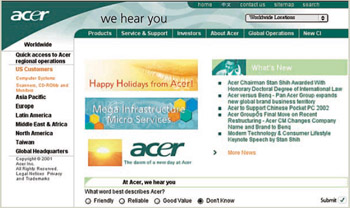
Figure 1.3: www.Acer.com (Feb. 2002)-Home page provides few clues about what Acer does.
Acer's home page asks, "Which word best describes Acer?" I'll guess that many visitors leave it set to Don't know.
Avoiding the Blooper
As an example of a website that explains its identity and purpose very well, check out the home page of Earthwatch (Figure 1.4). I don't have to explain what Earthwatch is; you can tell from its home page.
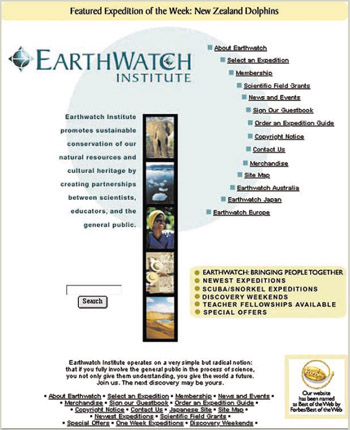
Figure 1.4: www.Earthwatch.org (Jan. 2002)-Home page clearly and succinctly describes what Earthwatch does.
Before and After: A Company Improves Its Home Page
37 Signals is a Web design firm. In early 2002, its website was clearly meant to show how unconventional and "bleeding edge" the firm was. The problem was, the home page was so unconventional that it provided no clues about what the company does (Figure 1.5). To find out what it does, visitors had to follow the link to the Start page. Not a good quality for the website of a Web design firm to have.
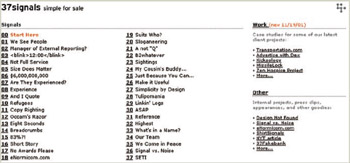
Figure 1.5: www.37Signals.com (Jan. 2002)-Home page was purposely unconventional but in doing so provided no clue what the company does. Hint- It designs websites. The company's revised home page is shown in Figure 1.6 in Avoiding the Blooper.
Predictably, the company soon realized this home page wasn't working and radically redesigned it; which is to say, the company redesigned it to be less radical . By June 2002, 37 Signals had a new home page (Figure 1.6).
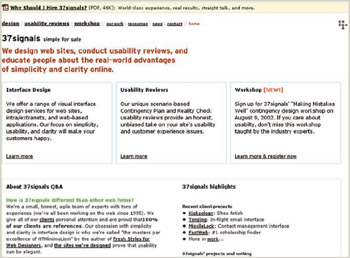
Figure 1.6: www.37Signals.com (June 2002)-Revised home page clearly describes what 37 Signals does.
Some people might say the new home page is too conventional. Okay, maybe an image or two might jazz it up a bit, but the purpose of this site is not to entertain ; it is to inform . The main question to ask is, therefore, can people tell where they are, and can they find what they are looking for? Without a doubt, the answer is yes.
Essential Ingredients of a Home Page
What makes Earthwatch's home page and 37 Signals' revised home page so successful at summarizing the purpose of their respective organizations and the content of the site? These sites have most or all of the following characteristics:
-
Organization name is placed prominently.
-
Organization name is fairly self-explanatory.
-
Brief textual summary of the organization's purpose is presented.
-
Picture(s) illustrate the organization's product or service.
-
Labels of links to other pages provide good overview of site contents.
Although all of these features act in concert to clarify the site's purpose, the most important one is the brief textual summary; it is mainly this that the sites shown as blooper examples lack.
Both the textual summary and the pictures need to make sense to organizational outsiders ( assuming the site is intended for outsiders). In particular, the textual summary should not rely on industry jargon or company organization names or abbreviations.
| < Day Day Up > |
EAN: 2147483647
Pages: 128